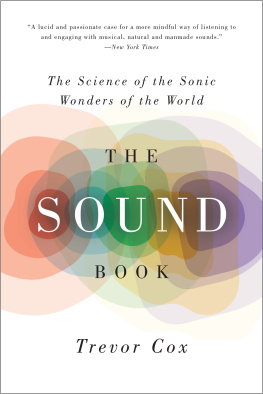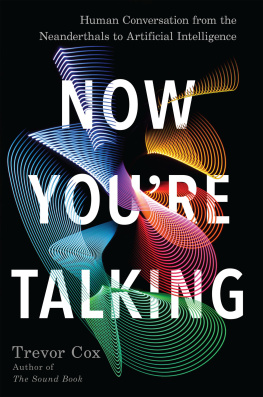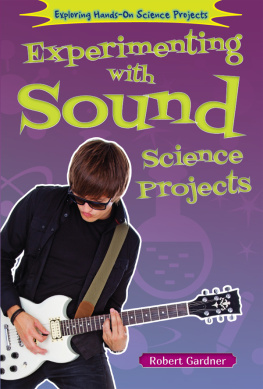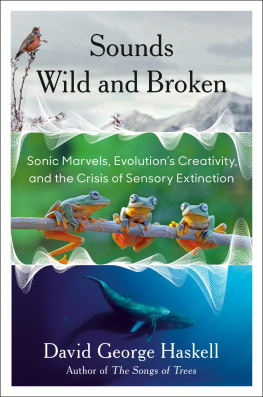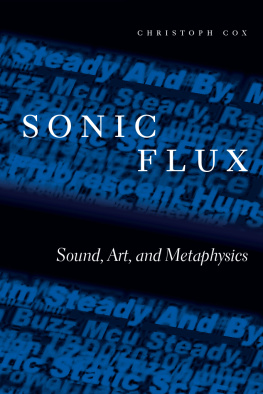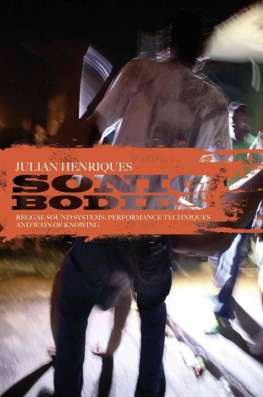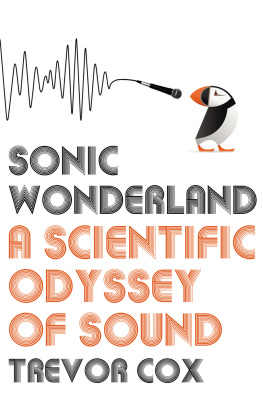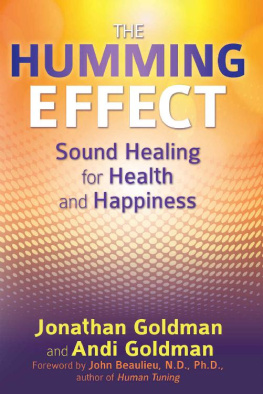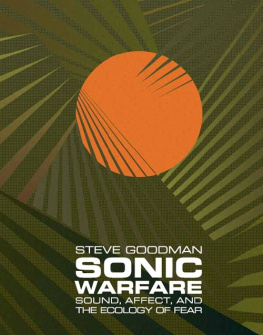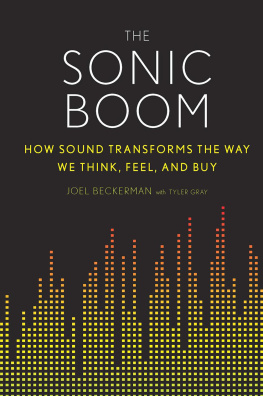

Copyright 2014 by Trevor Cox
First American Edition 2014
First published as a Norton paperback 2015
Published in Great Britain by The Bodley Head under the title Sonic Wonderland: A Scientific Odyssey of Sound
Illustration credits: Unless otherwise stated, images are drawn by Trevor and Nathan Cox. Richard Deane took the Aeolus photograph (Figure 4.1). The cat piano image (Figure 5.1) is courtesy of CNUM, Conservatoire Numrique des Arts et Mtiers, http://cnum.cnam.fr, La Nature , 1883, p. 320. The satellite image of clouds showing airflow around Alejandro Selkirk Island (Figure 8.7) is NASA Goddard Photo and Videos photo stream, http://www.flickr.com/photos/gsfc/5638320696/in/photostream, accessed January 9, 2013.
All rights reserved
For information about permission to reproduce selections from this book, write to Permissions, W. W. Norton & Company, Inc., 500 Fifth Avenue, New York, NY 10110
For information about special discounts for bulk purchases, please contact W. W. Norton Special Sales at specialsales@wwnorton.com or 800-233-4830
Book design by Chris Welch
Production manager: Devon Zahn
The Library of Congress has cataloged the printed edition as follows:
Cox, Trevor J.
The sound book : the science of the sonic wonders of the world /
Trevor Cox. First American edition.
pages cm
Includes bibliographical references and index.
ISBN 978-0-393-23979-9 (hardcover)
1. SoundsPopular works. 2. NoisePopular works. I. Title.
QC225.3.C69 2014
550.1534dc23
2013034491
ISBN 978-0-393-24282-9 (e-book)
ISBN 978-0-393-35058-6 pbk.
W. W. Norton & Company, Inc.
500 Fifth Avenue, New York, N.Y. 10110
www.wwnorton.com
W. W. Norton & Company Ltd.
Castle House, 75/76 Wells Street, London W1T 3QT
To Deborah
Contents
THE SONIC WONDERS OF THE WORLD

Is it safe? A noxious odor was invading my nostrils as I stared down the open manhole. The metal ladder disappeared into the darkness. I had assumed a radio interview on the acoustics of sewers would involve an official and authorized visit. Instead, it started with a walk into a London park on a summers evening. Bruno, the interviewer, produced a large key from his knapsack, opened up a convenient manhole cover, and invited me to climb down. Was it legal to wander around the sewers without permission? What if the tunnel suddenly flooded? What about a canary to warn of poisonous gases? Meanwhile, strolling commuters ignored us as we gazed into the gloom.
I repressed my anxieties and climbed gingerly down the ladder to the sewer about 6 meters (20 feet) below. This was a storm drain built in Victorian times, a long cylindrical tunnel lined with bricks. The floor was treacherous and slippery, and the odor made my skin crawl. I clapped my hands as best I could with rubber gloves on and started to count in my head very slowlyone, two, three,...timing how long it took the sound to die away. After 9 seconds a distant rumbling echo returned to me. Sound travels a kilometer (about a half mile) every 3 seconds, so my clap had traveled a round-trip of 3 kilometers (1.9 miles). Later on, far away down the tunnel, we discovered the staircase off which the sound had bounced; it was draped in disgusting debris.
I found it difficult to avoid head-butting the stalactites hanging from the low ceiling. Sadly, these were not brittle rock, but crusty, fatty deposits clinging to the bricks. These foul stalactites broke off, worked their way down the back of my shirt and scraped my skin. Since Im tall, my head was very close to the ceilingthe worst place for the revolting stalactites, but the optimal position for observing an unexpected acoustic effect. As the radio interview started, I noticed my voice hugging the walls of the cylindrical tunnel and spiraling into the distance. Speech spun around the inside of the curved sewer like a motorcyclist performing in a Wall of Death. While every other sense was being overwhelmed with revulsion, my ears were savoring a wonderful sonic gem. This impressive spiraling toyed with me as I tried to work out what was causing the effect. It was so different from anything I had experienced before that I started to doubt what I was hearing. Was it just an illusion, with the sight of the cylindrical sewer fooling my brain into thinking the sound was curving? No; when I closed my eyes, the reverberance still embraced my voice and twisted it around the tunnel. What was causing the sound to stay at the edges of the sewer and not cross into the middle? I have worked in architectural acoustics for twenty-five years, yet the sewer contained a sound effect I had not heard before. I also noticed that Brunos voice was embellished with a metallic twang as it echoed in the sewer. How was that possible in a place devoid of metal? We were surrounded by bricks.
During those hours listening to the sewer, I had an acoustic epiphany. My particular expertise is interior acousticsthat is, the way sound works in a room. Most of my work has focused on discovering ways to mask or minimize unwanted sounds and acoustic effects. Not long after completing my doctorate, I pioneered new ways of shaping room surfaces that now improve the sound in theaters and recording studios around the world. Above the stage of the Kresge Auditorium at the Massachusetts Institute of Technology, you can see the gently undulating reflectors I designed to help musicians hear each other. For a rehearsal hall at the Benslow Music Trust in Hitchin, England, I designed corrugations to adorn a concave wall in order to stop sound reflections from all being focused onto a single point in the room and thereby altering the timbre of the musical instruments.
In recent years I have been researching how poor acoustics and high noise levels in classrooms affect learning. It seems obvious that pupils need to be able to hear the teacher and have a certain amount of quiet to learn, yet there are architects who have designed schools that are acoustic disasters. My bte noire is open-plan schools, where doors and walls are dispensed with, resulting in the noise from one class disturbing others because there is nothing to impede the sound. The Business Academy Bexley in London opened in 2002 and was short-listed for the prestigious Royal Institute of British Architects Stirling Prize. The open-plan design caused so many noise problems, however, that the school and local education authority had to spend 600,000 ($0.9 million) installing glass partitions.1 Part of my research into schools involved playing noise at pupils as they tried to complete simple tasks involving reading comprehension or mental arithmetic. In one test, playing the babble of a noisy classroom at a cohort of fourteen- to sixteen-year-olds lowered their cognitive abilities to those of a control group of eleven- to thirteen-year-olds who were working in quieter conditions.
I am currently working with colleagues to improve the quality of user-generated content online. I started the project after getting frustrated listening to distorted and noisy soundtracks on Internet videos. We are developing software that will automatically detect when an audio recording is poorfor instance, checking whether there is wind noise whistling past a microphone. The idea is to alert users to poor sound conditions before they start recording, or to use audio processing to weed out some of the interference, just as a digital camera looks for flaws and automatically adjusts exposure time and focus. But before we can write the software, we are grappling with peoples perceptions of audio quality. When you record your child playing in a school concert, does the quality of the recording matter very much? My personal feeling is that audio distortions can be much more important than visual ones. A blurry video with a clear recording of a loved one singing captures that special moment much better than a clear video in which the lyrics are unintelligible and the voice distorted.
Next page
